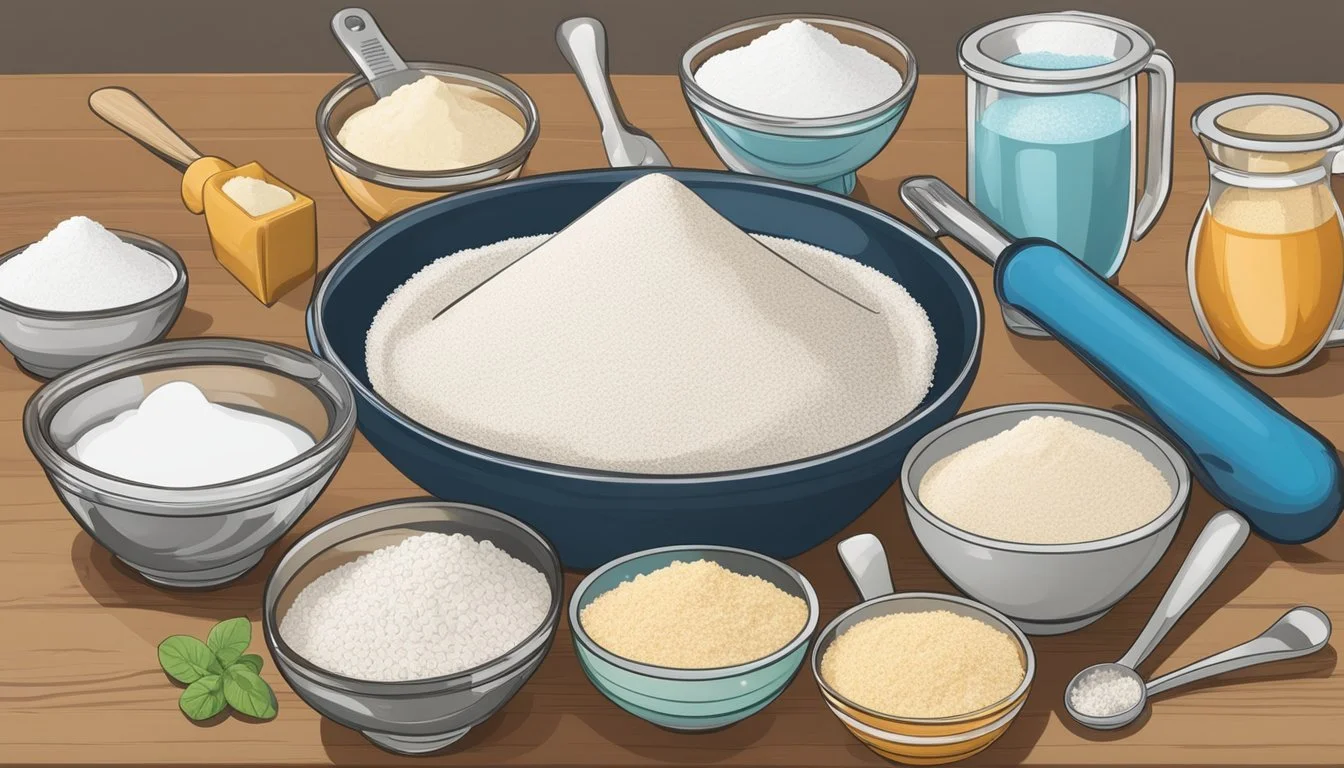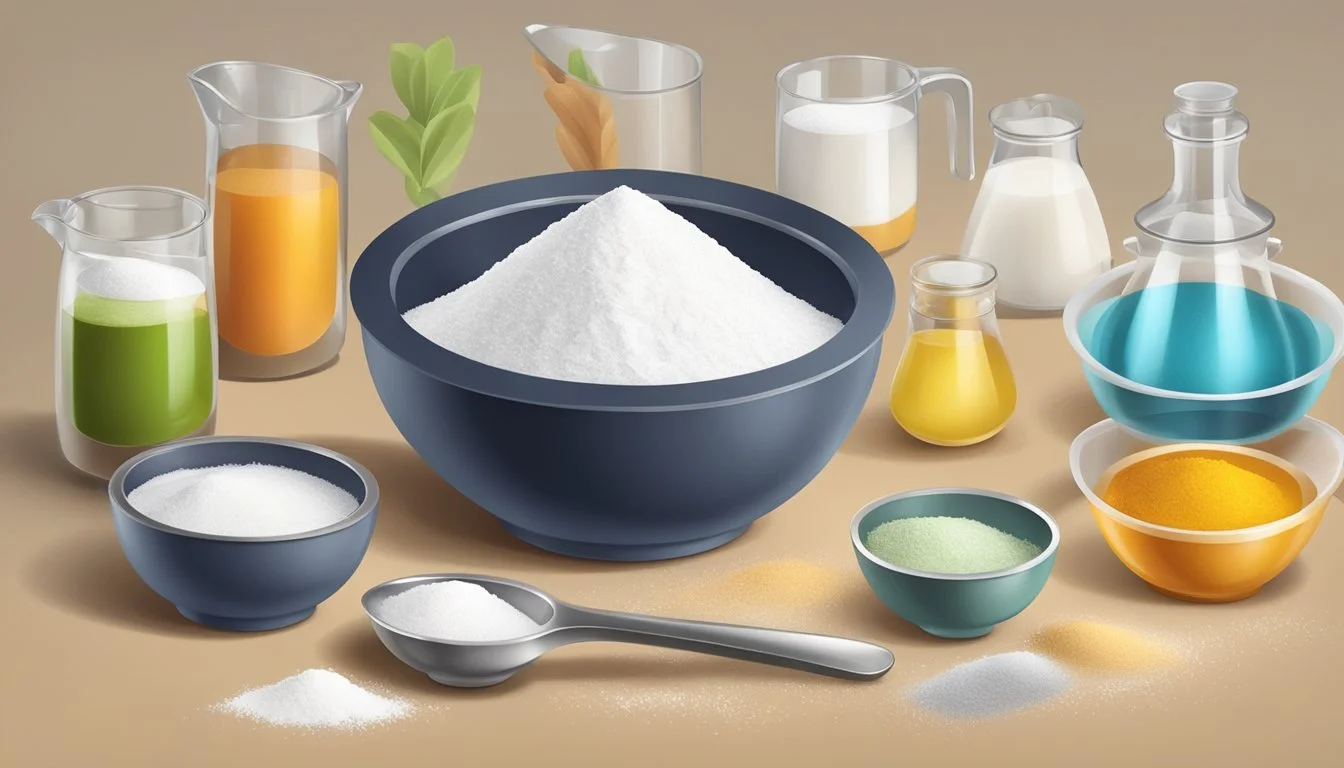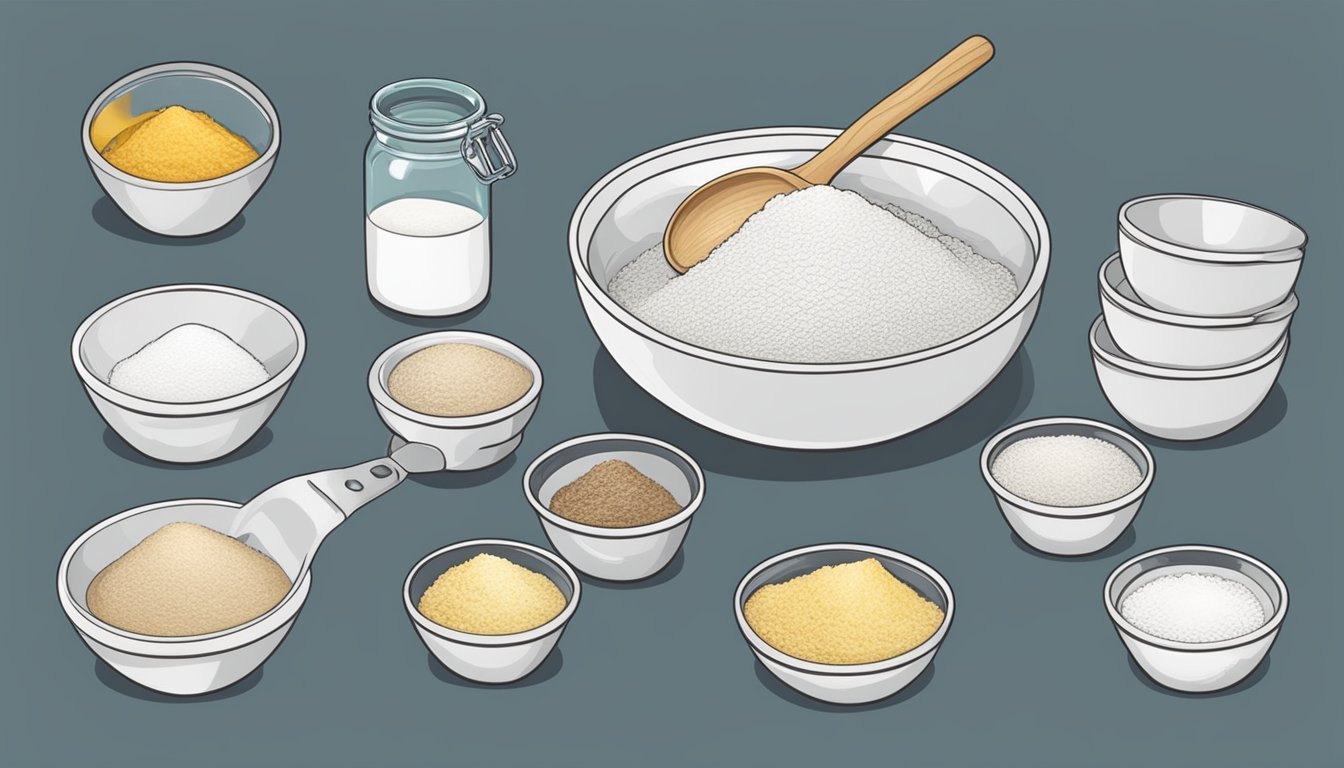How to Measure Ingredients for a Homemade Baking Mix
Precision for Perfect Results
Creating a homemade baking mix requires precision. Much like in any baking endeavor, measuring ingredients accurately is crucial, as it ensures the consistency and success of the final product. Since baking is a science, any variation in ingredient quantity can lead to vastly different outcomes. To prepare a reliable and versatile baking mix that can be a foundation for a variety of recipes, one must be meticulous in following measurements.
Measuring dry ingredients, including flour, sugar, and leavening agents, should be done with the spoon-and-level method. This involves spooning the ingredient into the measuring cup and sweeping a flat edge over the top to remove the excess. This technique helps prevent the common pitfall of packing too much ingredient into the cup. For smaller quantities, using measuring spoons and leveling off ensures a precise amount.
For liquid components, transparency is key. One should use a clear measuring cup with a spout and view the measurement at eye level to confirm accuracy. Ingredients like oils, water, and liquid sweeteners must be measured in their appropriate measuring tools to ensure that the homemade baking mix has the correct moisture content. Consistency in these practices across all components will help bakers achieve the desired results every time they reach for their homemade baking mix.
Understanding Baking Mix Components
Creating a homemade baking mix involves careful consideration of each ingredient's role and how they interact to produce the desired outcome. Accurate measurement ensures consistency in flavor, texture, and rise of the finished product.
Role of Flour in Baking Mixes
Flour, particularly all-purpose flour, serves as the structural backbone of most baking mixes. It provides the necessary gluten when mixed with moisture, which gives baked goods their shape and texture. Selecting the right type of flour, such as all-purpose for its balance of strength and tenderness, is crucial for the mix's versatility and performance.
Importance of Leavening Agents
Leavening agents like baking powder and baking soda are essential for introducing air and volume into baked goods. Baking powder, a combination of baking soda and an acid, typically reacts with moisture and heat to create lift. In contrast, baking soda requires an acidic ingredient within the mix to activate. They must be measured precisely to avoid under or over-leavening which can respectively lead to dense or coarse textures.
Utilizing Fats for Texture
Fats, including butter, oil, or even shortening, enrich baking mixes by contributing to the desired texture—flaky, crumbly, or tender. Butter adds flavor and can trap air when creamed, aiding in leavening. Oil, on the other hand, creates moistness and keeps products soft. The type and quantity of fat directly influence the final product's richness and mouthfeel.
Incorporating Sweeteners
Sweeteners are not just for taste; they also affect moisture and color. Granulated sugar is commonly used for its ability to tenderize and support browning. Brown sugar, with its molasses content, imparts a deeper flavor and additional moisture. Less common sweeteners like honey can contribute distinct flavors and retain moisture over time, influencing both the shelf-life and taste profile of baked creations.
Selecting and Measuring Ingredients
The successful outcome of a baking project hinges on careful selection and precise measurement of ingredients. This ensures consistency, optimal results, and reproducibility in recipes.
Choosing the Right Ingredients
Selecting high-quality ingredients is the foundation of any good baking mix. For example, all-purpose flour is typically the standard for baking, but bread flour or cake flour may be called for depending on the end product. Ingredients should be fresh and appropriate for the recipe, and any substitutions must maintain similar properties to avoid altering the result.
Accuracy in Dry Ingredient Measurement
Dry ingredients like flour, granulated sugar, and leavening agents require accurate measurement to produce the desired texture and rise. Use standardized dry measuring cups for larger amounts and measuring spoons for smaller quantities. To measure, one should fill the cup or spoon with the dry ingredient and level it off with a straight edge for precision. This is crucial because even slight variations can affect the chemistry of baked goods.
Common Dry Ingredient Measurements:
Tablespoons (Tbsp): often used for butter, herbs, and powders
Teaspoons (tsp): suitable for salts, spices, and extracts
Cups: the standard measure for bulk ingredients like flour and sugar
Measuring Liquid Ingredients
Liquid ingredients such as water, oil, or milk should be measured using a clear measuring cup designed for liquids. These cups allow for accurate readings at eye level, and it's important to check the measurement on a flat surface to avoid adding too much or too little. For smaller volumes, use measuring spoons rather than cups.
Liquid Measurement Equivalents:
1 cup = 8 fluid ounces
1 tablespoon = 1/2 fluid ounce
1 teaspoon = approximately 1/6 fluid ounce
Weighing Ingredients for Precision
Weighing ingredients on a kitchen scale can greatly enhance precision, particularly with ingredients that can compress or aerate, like flour. Scales provide an exact measurement and account for variance in ingredient density. When using a scale, first tare the scale to account for the container's weight, then add ingredients until you reach the desired weight.
Advantages of Using a Kitchen Scale:
Consistency: Weight is consistent regardless of ingredient volume.
Accuracy: Precise measuring to the gram or ounce.
Ease: Simplifies the process by allowing you to measure all ingredients in one bowl.
In conclusion, accurately measuring ingredients involves selecting the right ingredients and using the appropriate tools and techniques for each type of ingredient. By adhering to these practices, you can ensure reliable and delicious outcomes in your baking endeavors.
Customizing Your Baking Mix
Creating a personalized baking mix means one can adapt the base recipe to suit different tastes or dietary needs. This customization is straightforward and allows for a variety of flavors and ingredients to be included.
Adding Mix-Ins for Variety
A homemade baking mix can be elevated by adding various mix-ins to enhance the flavor and texture. When incorporating mix-ins such as chocolate chips, nuts, or blueberries, ensure they are evenly distributed to achieve consistency in every bite. Here is a suggestion for quantities to add to a standard-sized mix:
Chocolate Chips: 1/2 to 3/4 cup
Nuts (e.g., walnuts, almonds, chopped): 1/2 to 3/4 cup
Dried Fruit (e.g., raisins, cranberries): 1/2 cup
Blueberries (fresh or dried): 1/2 to 3/4 cup
Mix-ins should be folded into the dry mix or added during the final stages of mixing to prevent overworking the batter, which can lead to tough baked goods.
Modifying Mixes for Dietary Restrictions
To accommodate various dietary restrictions, substitutions can be made to the base baking mix. For a gluten-free option, one might replace wheat flour with a gluten-free flour mix, keeping in mind that the texture and flavor may be slightly different.
Gluten-Free Flour Mix: Replace the standard flour cup-for-cup with a gluten-free blend.
When adding chocolate to a mix, selecting a type that fits dietary preferences, such as dairy-free or sugar-free options, ensures that the baking mix caters to specific dietary needs. It's important to review the labels of all mix-ins to ensure they meet the required dietary standards.
Preparing Baking Mix for Different Baked Goods
Creating a homemade baking mix can simplify the process of baking a variety of goods. The versatility of the mix depends on the precise measuring of ingredients and understanding the unique requirements of each type of baked good.
Creating Mixes for Cookies and Muffins
For cookies and muffins, the baking mix should provide a balance between tenderness and structure. Using a base ratio of 1 cup of flour to 1 1/2 teaspoons of baking powder and 1/4 teaspoon of salt gives a starting point. For a richer texture, one might add a tablespoon of sugar for cookies or two tablespoons for muffins.
Cookies: Use the base mix and incorporate fat, such as butter or oil, and customize with chocolate chips, nuts, or dried fruits.
Muffins: Add liquid (like milk or buttermilk) and eggs to the dry mix, which provides leavening and moisture.
Adapting Mix for Cakes and Biscuits
Cakes require a lighter mix for a fluffy and soft texture, while biscuits need a heartier mix for a flaky and tender crumb.
Cakes: Include more sugar in the mix for sweetness and browning, and use cake flour instead of all-purpose flour to keep the mix light. Ensuring the mix is well-sifted helps aerate the flour, which is critical for cake textures.
Biscuits: The mix should have a higher fat content, with butter or shortening cut into the dry ingredients until it resembles coarse crumbs. The addition of buttermilk activates the baking powder, creating rise and tanginess.
Homemade Mixes for Pancakes and Waffles
The mix for pancakes and waffles should create a batter that's pourable yet thick enough to hold its shape on a griddle or waffle iron.
Pancakes: Start with the same base as for cookies and muffins, and thin the mix out with more liquid. Pancake batter should pour easily and spread into a round shape on the griddle.
Waffles: They need a higher fat content and more sugar than pancakes for a crispy exterior. Incorporating beaten egg whites into the batter can add lightness to the waffles.
In each case, homemade bisquick can function as an all-purpose base mix that's adjustable for each specific baked good, from cookies to waffles, ensuring successful and delicious results.
Storage and Shelf Life
When creating a homemade baking mix, the two paramount considerations are how it is stored and understanding its shelf life. Proper storage will maximize freshness and usability, while knowledge of expiration ensures quality and safety.
Storing Baking Mixes Properly
Storing homemade baking mixes correctly is crucial for maintaining their quality. Containers used for storage must be airtight, as exposure to air can lead to moisture buildup and spoilage. Glass jars with tight-sealing lids or plastic containers with snap-on lids are excellent choices. After preparing the mix, it should be transferred to the chosen container, ensuring that there is minimal air space.
Using an airtight container is especially important if the baking mix includes fats like shortening which can go rancid. If one lives in a warmer climate or the mix contains these fats, then storing the baking mix in the refrigerator is recommended. This will not only prevent the growth of bacteria but also keep the fats from turning rancid prematurely.
Understanding Expiration and Freshness
The shelf life of a homemade baking mix is often determined by the individual shelf lives of its ingredients – typically ranging from 3 to 6 months. However, the presence of any added dairy or fat can shorten this period. Proactive steps should be taken to mark the container with the date of preparation to avoid using expired mix.
Ingredient Shelf Life Storage Note Flour 3-6 months Cool, dry place Baking Powder 6-12 months Dry, and away from heat Shortening 8-12 months Refrigerate to extend life
It is important to always test ingredients like baking soda and powder for freshness before using them in a mix. Baking soda should bubble immediately when mixed with vinegar, and baking powder should produce a similar reaction when combined with warm water. If these ingredients fail to react, they won't provide the necessary leavening in baked goods, compromising the mix's effectiveness.
Nutritional Information and Adjustments
When crafting a homemade baking mix, understanding the nutritional profile is crucial for health-conscious consumers and those with dietary restrictions. Adjustments can customize the mix to lower calorie or fat content without sacrificing taste.
Calculating Nutritional Content
To calculate the nutritional content of a baking mix, one must consider the cumulative nutritional value of all ingredients. For instance:
Calories are the total energy provided by all components.
Total Fat includes saturated and unsaturated fats.
Cholesterol and Sodium affect the heart health aspect of the mix.
Protein, Iron, Calcium, Potassium contribute to the mix's utility as part of a balanced diet.
Vitamin C is less common in baking mixes but may be present in ingredients like fruit zest.
A nutrition calculator can assist in tallying these values for the complete mix.
Making Low-Calorie or Low-Fat Mixes
For lower calorie or fat versions, substitution is key:
Replace sugar with sweeteners like stevia to reduce calories.
Use apple sauce instead of oil to cut total fat.
Incorporate whole grain flours to increase fiber and protein.
One can also adjust for saturated fat by opting for unsaturated fats like canola oil, and lower cholesterol by using egg substitutes. Enriching mixes with calcium and iron can be done by adding fortified ingredients. To moderate sodium, simply decrease salt.
Additional Baking Tips and Techniques
Achieving the perfect homemade baking mix often relies on precision and the way one handles the ingredients and equipment. Below are some targeted techniques for ensuring consistent quality in your baking endeavors.
Using a Pastry Blender for Mixing
A pastry blender is essential for incorporating fats like butter into flour without overworking the mixture. They should hold the pastry blender firmly and cut through the ingredients with a motion that blends without pressing too hard. This avoids overdeveloping the gluten, which can lead to tough textures.
Baking Consistently with a Baking Sheet
To achieve uniform cooking, chefs should utilize baking sheets that are heavy-gauge to promote even heat distribution. They must ensure that the baking sheet is properly preheated as part of the oven's overall temperature calibration. It is also helpful to rotate the baking sheet midway through the baking time.
Proper Mixing Techniques
When measuring flour, chefs should use the spoon and level method: they first sift the flour to aerate it, then gently spoon it into the measuring cup, and finally level it off with a flat edge. This provides a precise measure without compacting the flour. A careful fold or gentle stir is often all that's needed to combine ingredients without overmixing, which can affect the texture of the final product.
FAQs and Troubleshooting
When preparing a homemade baking mix, it's important to measure ingredients accurately to ensure consistent results, especially when aiming for high rating dessert recipes. Here are some frequently asked questions and their solutions:
Q: How can one tell if they've measured flour correctly for a homemade baking mix? A: Flour should be spooned into the measuring cup and leveled off with the back of a knife. A properly measured cup of flour will weigh approximately 130 grams. If the dessert recipes require precision, consider using a kitchen scale.
Q: What is the most common measuring mistake made in dessert recipes? A: One common mistake is using the measuring cup to scoop up flour, which can compact it and result in using too much. Instead, they should use the spoon and level method.
Measurement Common Error Correct Method Flour Overpacking Spoon and level Sugar Inconsistency Use standard measuring cups/spoons Baking Powder Misreading Check expiration date; level spoon
Q: How does one adjust the recipe when wanting to alter the serving size of the dessert recipes? A: For homemade mixes, doubling ingredients requires simple multiplication, but be cautious of the baking time and oven temperature. It may need adjustments to accommodate more or a larger size of the dessert.
Q: Why are my baked goods from my homemade mix turning out too hard? A: This could be due to over-measuring flour or other dry ingredients. Always weigh the flour for accuracy or use the correct spoon and level method described earlier.
Remember, precision in measuring is key to the success of a homemade baking mix and the quality of the finished dessert.
Conclusion
Accurate measurement of ingredients is crucial when preparing a homemade baking mix. A well-crafted mix requires a balance of pantry staples, ensuring consistency and success in baking. Here are key takeaways:
Measuring Cups and Spoons: Utilize a set of measuring cups and spoons for dry and wet ingredients. Standard sets include 1 cup, 1/2 cup, 1/3 cup, 1/4 cup for cups and 1 tablespoon down to 1/4 teaspoon for spoons.
Scale for Precision: For ingredients listed by weight such as flour or sugar, a kitchen scale ensures precision. Zero out the scale after placing a bowl on it to account only for the weight of the ingredients.
Spoon and Level: When measuring flour, one should spoon it into the measuring cup and level it off with a knife. This method prevents packing, which can result in using more flour than the recipe calls for.
Visible Shortening: When incorporating shortening into a baking mix, it should remain pea-sized within the mix to create the desired texture.
Creating a homemade baking mix with precise measurements of pantry ingredients brings a sense of accomplishment and reliability to any kitchen. The importance of these measuring techniques cannot be overstated, as they are instrumental in achieving a consistent homemade product every time one bakes.







